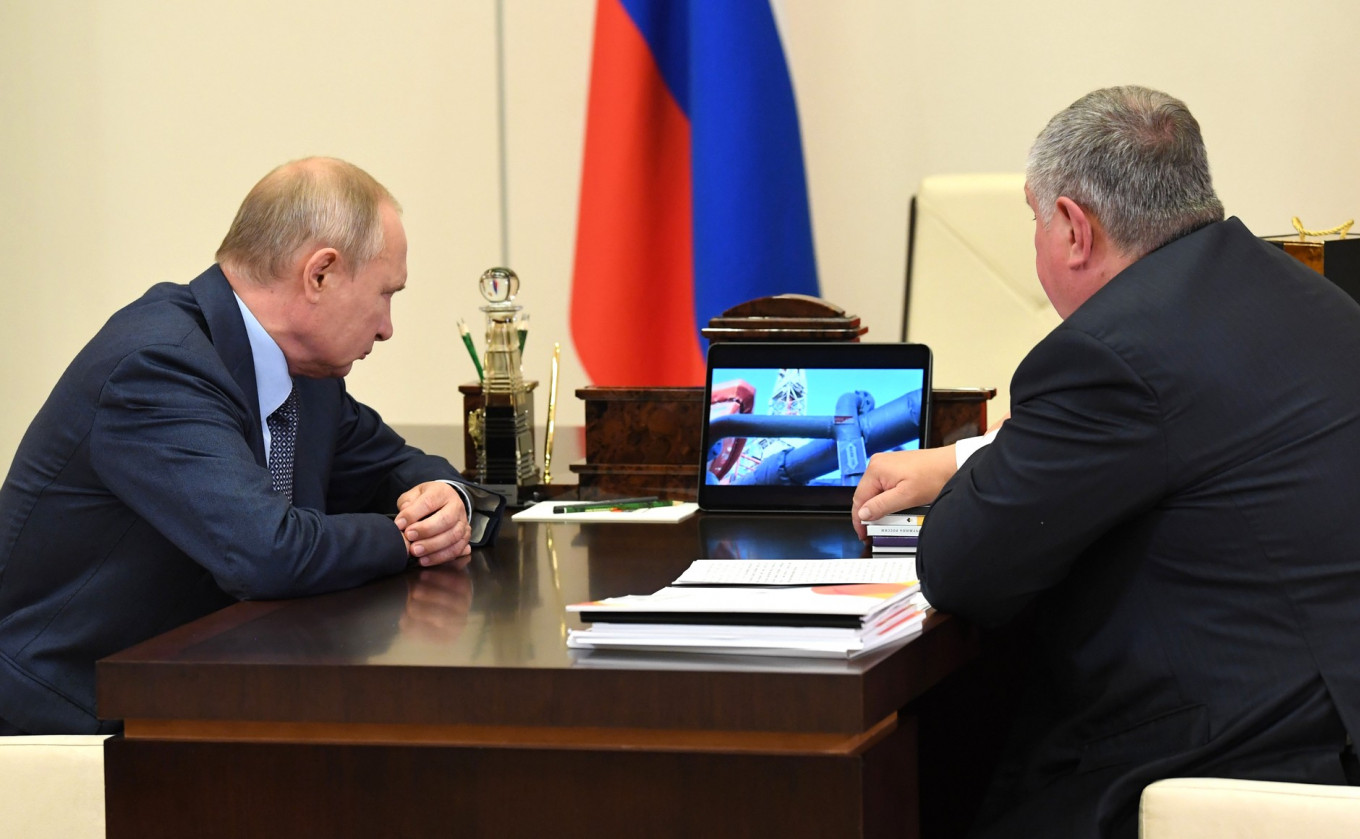
Rosneft head Igor Sechin has presented Vladimir Putin with a souvenir from the state oil giant’s latest Arctic drilling project: A small bottle of the oil itself.
The oil extracted from the Zapadno-Irkinsky field contains only 0.02% of sulphur, Sechin said as he handed the bottle to Putin during their meeting Tuesday. It is the first oil extracted from the site, Sechin explained.
“This is premium-quality oil, among the best in the world, the best in the world,” he emphasized.
Vostok Oil
The development of the Zapadno-Irkinsky field is part of Rosneft’s grand new Arctic project Vostok Oil. If the company gets its way, this will be one of the biggest energy projects in the Arctic ever.
Sechin showed the president a demonstration film of the project that will include the construction of about 2,000 kilometers of new long distance pipelines as well as 7,000 kilometers of local branch pipelines. The project’s construction will include three new airports, 10 helipads and about 50 new ice-class tankers, Interfax reported.
The Vostok Oil project also includes the building of a major new seaport and terminal on the coast of the the Kara Sea. The Sever terminal will be located on the western coast of the Taimyr Peninsula, not far from the town of Dikson. It will be built to handle all shipments from the project, ultimately up to 115 million tons of oil per year by 2030.
The Sever terminal is expected to be up and running by 2024. It will be instrumental in boosting shipments on the Northern Sea Route to more than 80 million tons, the grand target set by President Putin in his so-called May Decrees.
According to Sechin, Vostok Oil has a resource potential of up to 5 billion tons of light-quality oil. Already in 2024, up to 25 million tons are to be extracted. Three years later, in 2027, production will amount to 50 million tons and in 2030 — as much as 115 million.
Resources are based on 15 fields in the Taimyr region, including wells in the Vankor area. In the estimates are also the resources of the Payakha fields, as well as the East Taimyr cluster where Rosneft cooperates with BP.
Drilling in Kara Sea
Rosneft is not only actively involved in the Taimyr Peninsula but currently also drills in the Kara Sea, Sechin told Putin in this week’s meeting.
In addition to the bottle of oil from Taimyr, the Rosneft leader gave the president a stack of books, including one titled “Drilling in the Kara Sea.”
Offshore exploration is indeed taking place, Sechin said. According to the Rosneft leader, two rigs are currently drilling in the waters off the Novaya Zemlya archipelago.
Well drilling at the Vikulovskaya and Ragozinskaya started on July 22 and is carried out by two rigs that have been towed to the site from Murmansk.
The wells are located in the Vostochno-Prinovozemelsky 1-2 license areas, near the drillsite where Rosneft in 2014 made a major discovery in partnership with ExxonMobil.
According to Sechin, the area’s shallow waters and drifting icebergs have complicated operations and the company decided to drill a two-meter-wide, 15-meter-deep shaft to facilitate exploration.
It is the first time ever in Russia that such a procedure has been made in offshore drilling, he told Putin. The two rigs refered to by Sechin are likely to be the same that this summer drill two wells in the Kara Sea for Gazprom.
Drilling souvenirs
This is not the first time that Sechin has given the president a souvenir from his Arctic operations. In 2017, the Rosneft leader handed Putin a drillcore from the Tsentralny-Olginskaya well in the Laptev Sea.
According to Sechin, preliminarily technical studies indicated that the field holds geological reserves of up to 9.5 billion tons. “This will truly be a unique oil field,” Rosneft leader Igor Sechin underlined. Since then, however, little has been said about developments on site.
Nor is it the first time Putin and Sechin have discussed the Vostok Oil project. The two also raised the topic during their meetings February and May this year.
